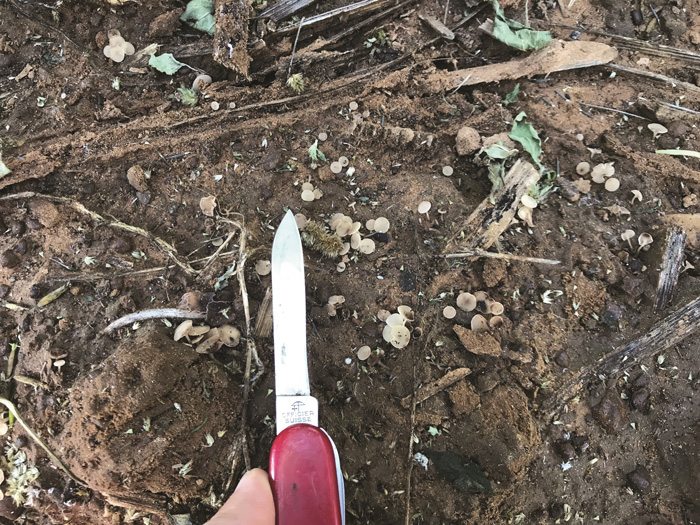
 Dr Lisa Rothmann, University of the Free State
Dr Lisa Rothmann, University of the Free State
Dr Miekie Human, Research and Policy Centre, Grain SA
A good understanding of how diseases caused by Sclerotinia sclerotiorum develop will help determine interventions that will mitigate, delay, or manage the disease intensity. When environmental conditions are cool and moist, Sclerotinia infects plants in two ways, either by the most common entry through the roots (by white mould on the ground) or wounds or natural openings, such as the flowers, during the flowering stage (by spores).
Sclerotinia sclerotiorum is a fungal pathogen causing significant epidemics of canola and soybean stem rot, as well as sunflower head rot. Symptoms associated with Sclerotinia diseases are sudden wilting and the stems/heads of infected plants becoming covered in a dense white fungal growth, known as mycelium. Towards the end of the growing season and pathogen lifecycle the mycelium develops into sclerotia, the hard black survival structures. Sclerotia may develop on the inside and outside of the stems, pods or head (Photo 1).
This article is the second of two that are an extension of a summary of the ‘Tactics to disrupt Sclerotinia’ article (Click on the QR code to read the article). The focus of this article is to provide cultural control strategies that can be useful in managing Sclerotinia diseases. Cultural control practices include crop rotation, reducing plant density, and practices to reduce spore production and release. These cultural control practices follow key strategies of avoidance, exclusion and eradication (Table 1). Various tactics exist within each of these strategies to manage Sclerotinia diseases (Zadoks & Schein, 1979). The previous article in this series focused on chemical control of Sclerotinia diseases.
Discussed below are the various tactics within the three key strategies suggested at a recent Sclerotinia Research Day:

Photo: Godfrey Kgatle

Avoidance as focus
- Avoid a dense canopy
- Sclerotinia thrives in a cool and moist environment, particularly at a microclimate level where sclerotia can be found on the soil surface. Avoid the formation of an overly dense soybean canopy. Recent studies on a range of different crops have shown that a canopy can increase disease incidence (O’Sullivan et al., 2021). The canopy provides the ideal microclimate for sclerotia to germinate to form structures that will release and spread infectious spores. A dense canopy is favoured by narrow row width, high plant populations and high soil fertility.
- Avoid coinciding flowering stage with conducive periods for pathogen
 Canola, soybean, and sunflower are normally more susceptible to S. sclerotiorum from flowering to flowers dying off. Avoid the co-occurrence of spore release during the rainy summer days with flowering. Where possible, plan for the completion of pod formation by the time environmental conditions are conducive for germination of sclerotia. Preferably use registered chemical control just before the flowering period to suppress disease development (click on the QR code to read ‘Sclerotinia diseases: Biological and chemical control’). Avoid irrigating during the flowering period as this may favour the germination of sclerotia encouraging apothecia development and ascospore release, increasing the risk for disease development. Apothecia are spore-producing structures found on the ground (Photo 2).
Canola, soybean, and sunflower are normally more susceptible to S. sclerotiorum from flowering to flowers dying off. Avoid the co-occurrence of spore release during the rainy summer days with flowering. Where possible, plan for the completion of pod formation by the time environmental conditions are conducive for germination of sclerotia. Preferably use registered chemical control just before the flowering period to suppress disease development (click on the QR code to read ‘Sclerotinia diseases: Biological and chemical control’). Avoid irrigating during the flowering period as this may favour the germination of sclerotia encouraging apothecia development and ascospore release, increasing the risk for disease development. Apothecia are spore-producing structures found on the ground (Photo 2).- Avoid late planting dates
- Late planting can cause some problems for crops. If producers plant later than recommended for their production region, their crops might still be developing in late March and April when the conditions are colder and dew remains on the crop for extended periods, creating a microclimate favouring the pathogen.

Photo: Lisa Rothmann
Sclerotinia management by exclusion
- Use healthy seed. Retained seed can be a risk if infected with mycelium or contaminated with sclerotia which are not removed through sieving. As such, it is recommended to thoroughly clean seed before planting. The purchase of certified seed ensures limiting pathogen presence in fields, as certified seed may not contain more than 0,2% sclerotia, a standard set by the South African National Seed Organisation (SANSOR). Seed treatments should be applied to keep seed as healthy as possible, reducing the risk of disease spreading.
Sclerotinia management by eradication
- Manage the inoculum level.
- Inoculum refers to the amount of pathogen (sclerotia and infected plant material) present in the field, posing a risk for disease development.
- Scouting for the pathogen, i.e., apothecia, throughout the season provides an indicator of disease risk. As apothecia germinate, they release ascospores and under conducive conditions there is greater potential for the onset of disease. Try and avoid confusing apothecia with non-plant-pathogenic fungi such as the common bird’s nest fungus (Photo 3). Regular drone or satellite images during the season may be useful as an overview of the field.
- Once symptoms are present in the field, a record of infected areas or ‘patches’ should be mapped out and maintained, allowing the producer to target future scouting for apothecia, as sclerotia will develop as disease progresses or the season comes to an end.
- The inoculum load can be reduced by selectively removing and burning heavily infected plants (if there are only a few). Additionally, crop rotations with non-hosts may reduce the sclerotia build-up and persistence across seasons.
 Weed control is important, as many weeds are hosts to S. sclerotiorum – those confirmed in South Africa are the common blackjack (Bidens pilosa), common cosmos (Bidens formosum), pigweed (Amaranthus deflexus) and tall khakibos (Tagetes minuta). Click on the QR code for more information.
Weed control is important, as many weeds are hosts to S. sclerotiorum – those confirmed in South Africa are the common blackjack (Bidens pilosa), common cosmos (Bidens formosum), pigweed (Amaranthus deflexus) and tall khakibos (Tagetes minuta). Click on the QR code for more information.

Photo: Lisa Rothmann
There is no silver bullet in Sclerotinia disease management – an IPM approach to manage sclerotinia stem and head rot is recommended. Select and combine cultural control tactics which suit the production system. In summary: rotation with non-host crops, plant clean or certified seed, increase row spacing or reduce plant populations, practice weed control, and clean implements and harvesters to remove sclerotia. The information in this article supplements the information regarding biological and chemical control by treatment of seeds and spray programmes during the period of greatest susceptibility of the crop (beginning of flowering until the beginning of pod formation) that appeared in the August 2023 edition of SA Graan/Grain.
Resource
- O’Sullivan, CA, Belt, K. & Thatcher, LF. 2021. Tackling control of a cosmopolitan phytopathogen: Sclerotinia. Frontiers in Plant Science, 12, p.707509.
- Zadoks, JC & Schein, RD. 1979. Epidemiology and Plant Disease Management. Oxford University Press, New York.
Contact Dr Lisa Rothmann at CoetzeeLA@ufs.ac.za or 079 270 9691; Dr Miekie Human at miekie@grainsa.co.za or 067 016 9493 or Dr Godfrey Kgatle at godfrey@grainsa.co.za or 079 489 5966 for further information or when you notice Sclerotinia in your field. This information will be important for surveillance and mapping the distribution of Sclerotinia diseases. For updates, visit the South African Sclerotinia Research Network (SASRN) website (http://sclerotinia.co.za/) or Facebook page (https://www.facebook.com/sclerotiniaZA).





























